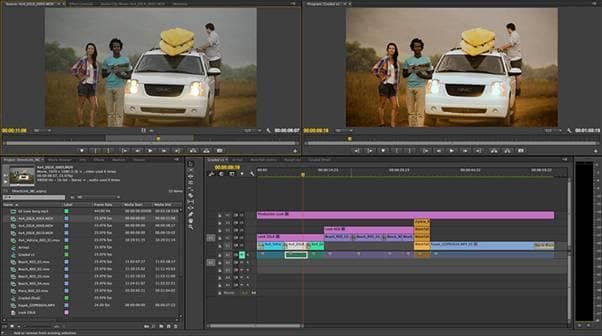
- #Adobe premiere vs after effects full
- #Adobe premiere vs after effects pro
- #Adobe premiere vs after effects software
- #Adobe premiere vs after effects professional
- #Adobe premiere vs after effects free
If you want to do more than correct basic video problems and add color grades After Effects will be the program you turn to time and time again. Why: This is where After Effects really shines.
#Adobe premiere vs after effects pro
For basic effects, Premiere Pro more than has you covered. You can also create titles, quickly correct color, and remove video and color noise. It includes surprisingly powerful tools like Warp Stabilizer that you’d never guess were included effects in a non-linear editing program.
#Adobe premiere vs after effects professional
#Adobe premiere vs after effects software
has hundreds of tutorials for all its software to help guide you through the different features that are available.

It’s time to put these programs up against each other and see which ones excel in each of our key categories: Ease of Use There are even some 3d modeling capabilities within this tool. It’s also easy to do things like adding transitions between video clips in your timeline.Īfter Effects, however, heavily focuses on visual effects and manipulating and adding to the footage itself to create stunning visual effects (think text drop-ins, special effects like fire and lightning, and image manipulation like picture-in-picture). The Main Differences Between After Effects and Premiere ProĪdobe Premiere Pro was mainly designed to be a non-linear editing program, so its features heavily lean towards making the assembly of multi-shot video footage and audio as simple as possible. They both allow you to manipulate video footage, adjust color, and add special effects, resulting in a much more polished image than raw footage alone. Make sure to check out our blogs page to learn more tips & tricks.On a basic level, After Effects and Premiere Pro are both video editing programs. If you have questions, post them below and I’ll see you in the next one. Having after effects in your TOOLBELT is one of the best things you can do to up your motion graphics level and the amount of online resources on it are endless. I like to do that part in Premiere so that I can go back and change it whenever I want to without having to re render from after effects.īut anyway, I hope this was helpful in some way.
#Adobe premiere vs after effects free
Where I see fit at this stage, feel free to add further polishes like a simple drop shadow to emphasize the text.

Now when I drop in the graphics and premiere, they’ll have transparency and are ready to be used. Instead of having a black background, I’ll set the audio output to off because I don’t have any audio in the animation, set my output location and hit render. The alpha is the actual information needed for it to have transparency. Here’s the important part in the channel section. But for this example, quick time animation will do just fine. Some codecs are better than others depending on what you’re doing.
#Adobe premiere vs after effects full
Make sure the quality and resolution are set to best and full in the output module.Ĭhange the format to quick time in the format options.

Once you’ve finished creating your animation in after effects, press control + M on your composition to get it ready for rendering and the render settings.

Well, you have to make sure of is that the graphics have a transparency and not a black background. Exporting motion graphics from after effects to Premiere Pro is actually pretty easy. That’s not because I’m better at After effects this just because after Effects was made for motion graphics and visual effects specifically, but premiere’s made for editing. I can probably create the same animation and after effects and half the time that I would in Premiere. First off, Premiere’s user interface is just a little bit clunky and not perfectly optimized for creating motion graphics animations.


 0 kommentar(er)
0 kommentar(er)
